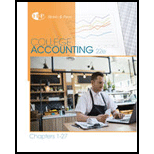
College Accounting, Chapters 1-27
23rd Edition
ISBN: 9781337794756
Author: HEINTZ, James A.
Publisher: Cengage Learning,
expand_more
expand_more
format_list_bulleted
Textbook Question
Chapter 13, Problem 5MC
In the application of “lower-of-cost-or-market,” market is the
- (a) lowest sales price.
- (b) highest sales price.
- (c) replacement cost.
- (d) average sales price.
Expert Solution & Answer
Want to see the full answer?
Check out a sample textbook solution
Students have asked these similar questions
I need this question answer general Accounting
If you give me wrong answer I will give you unhelpful rate for this financial accounting question
Hi expert provide correct answer general accounting
Chapter 13 Solutions
College Accounting, Chapters 1-27
Ch. 13 - An overstatement of ending inventory in the year...Ch. 13 - An understatement of ending inventory in the year...Ch. 13 - LO2 Under the perpetual system of accounting for...Ch. 13 - LO3 A fiscal year that starts and ends at the time...Ch. 13 - LO3 If goods are shipped FOB shipping point, the...Ch. 13 - An understatement of ending inventory in the year...Ch. 13 - Prob. 2MCCh. 13 - In rimes of rising prices, the inventory cost...Ch. 13 - In rimes of rising prices, the inventory cost...Ch. 13 - In the application of lower-of-cost-or-market,...
Ch. 13 - LO1 If the ending inventory is overstated by...Ch. 13 - Using the following information, compute the...Ch. 13 - Use the following information to compute cost of...Ch. 13 - Kulsrud Company would like to estimate the current...Ch. 13 - What financial statements are affected by an error...Ch. 13 - What is the main difference between the periodic...Ch. 13 - Is a physical inventory necessary under the...Ch. 13 - Is a physical inventory necessary under the...Ch. 13 - In a period of rising prices, which inventory...Ch. 13 - What two factors are taken into account by the...Ch. 13 - Which inventory method always follows the actual...Ch. 13 - When lower-of-cost-or-market is assigned to the...Ch. 13 - List the three steps followed under the gross...Ch. 13 - List the five steps followed under the retail...Ch. 13 - INVENTORY ERRORS Assume that in year 1, the ending...Ch. 13 - JOURNAL ENTRIESPERIODIC INVENTORY Paul Nasipak...Ch. 13 - JOURNAL ENTRIESPERPETUAL INVENTORY Joan Ziemba...Ch. 13 - ENDING INVENTORY COSTS Sandy Chen owns a small...Ch. 13 - LOWER-OF-COST-OR-MARKET Stalberg Companys...Ch. 13 - SPECIFIC IDENTIFICATION, FIFO, LIFO, AND...Ch. 13 - COST ALLOCATION AND LOWER-OF-COST-OR-MARKET...Ch. 13 - Prob. 8SPACh. 13 - RETAIL INVENTORY METHOD The following information...Ch. 13 - INVENTORY ERRORS Assume that in year 1, the ending...Ch. 13 - JOURNAL ENTRIESPERIODIC INVENTORY Amy Douglas owns...Ch. 13 - JOURNAL ENTRIESPERPETUAL INVENTORY Doreen Woods...Ch. 13 - ENDING INVENTORY COSTS Danny Steele owns a small...Ch. 13 - LOWER-OF-COST-OR-MARKET Bouie Companys beginning...Ch. 13 - SPECIFIC IDENTIFICATION, FIFO, LIFO, AND...Ch. 13 - COST ALLOCATION AND LOWER-OF-COST-OR-MARKET Hall...Ch. 13 - GROSS PROFIT METHOD A flood completely destroyed...Ch. 13 - RETAIL INVENTORY METHOD The following information...Ch. 13 - Hurst Companys beginning inventory and purchases...Ch. 13 - Bhushan Company has been using LIFO for inventory...
Knowledge Booster
Learn more about
Need a deep-dive on the concept behind this application? Look no further. Learn more about this topic, accounting and related others by exploring similar questions and additional content below.Similar questions
arrow_back_ios
SEE MORE QUESTIONS
arrow_forward_ios
Recommended textbooks for you
 College Accounting, Chapters 1-27AccountingISBN:9781337794756Author:HEINTZ, James A.Publisher:Cengage Learning,
College Accounting, Chapters 1-27AccountingISBN:9781337794756Author:HEINTZ, James A.Publisher:Cengage Learning, Intermediate Financial Management (MindTap Course...FinanceISBN:9781337395083Author:Eugene F. Brigham, Phillip R. DavesPublisher:Cengage LearningPrinciples of Accounting Volume 1AccountingISBN:9781947172685Author:OpenStaxPublisher:OpenStax College
Intermediate Financial Management (MindTap Course...FinanceISBN:9781337395083Author:Eugene F. Brigham, Phillip R. DavesPublisher:Cengage LearningPrinciples of Accounting Volume 1AccountingISBN:9781947172685Author:OpenStaxPublisher:OpenStax College Survey of Accounting (Accounting I)AccountingISBN:9781305961883Author:Carl WarrenPublisher:Cengage Learning
Survey of Accounting (Accounting I)AccountingISBN:9781305961883Author:Carl WarrenPublisher:Cengage Learning

College Accounting, Chapters 1-27
Accounting
ISBN:9781337794756
Author:HEINTZ, James A.
Publisher:Cengage Learning,

Intermediate Financial Management (MindTap Course...
Finance
ISBN:9781337395083
Author:Eugene F. Brigham, Phillip R. Daves
Publisher:Cengage Learning

Principles of Accounting Volume 1
Accounting
ISBN:9781947172685
Author:OpenStax
Publisher:OpenStax College

Survey of Accounting (Accounting I)
Accounting
ISBN:9781305961883
Author:Carl Warren
Publisher:Cengage Learning

Fixed Asset Replacement Decision 1235; Author: Accounting Instruction, Help, & How To;https://www.youtube.com/watch?v=LJRzn9K8Nwk;License: Standard Youtube License